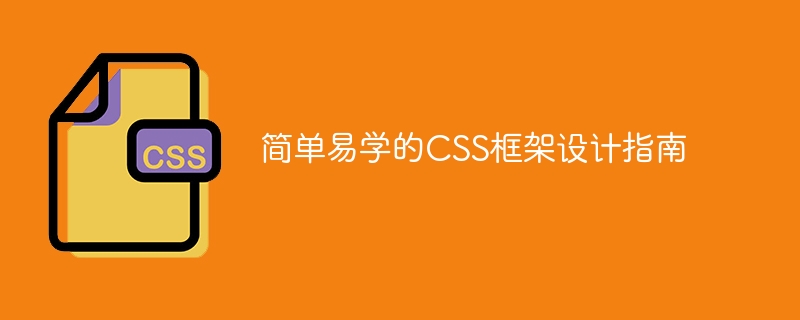Home >Web Front-end >CSS Tutorial >CSS Framework Design Guide: A simplified approach that's easy to learn and applicable
CSS Framework Design Guide: A simplified approach that's easy to learn and applicable
- WBOYWBOYWBOYWBOYWBOYWBOYWBOYWBOYWBOYWBOYWBOYWBOYWBOriginal
- 2024-01-05 08:32:341433browse

Easy-to-learn CSS framework design guide
CSS framework is a commonly used tool in front-end development, which can quickly achieve uniformity of page layout and style. This article will introduce a simple and easy-to-learn CSS framework design guide and provide specific code examples to facilitate readers to learn and use.
- Simplify the structure
A good CSS framework should try to simplify the HTML structure and reduce redundant code. Only use a small number of classes and ids, and try to avoid nesting selectors too deeply. Using BEM naming conventions can effectively maintain styles and improve code readability.
The following is a simple HTML structure example:
<div class="container">
<div class="section">
<h1 class="title">标题</h1>
<p>正文内容</p>
</div>
</div>- Responsive design
Modern web design needs to be compatible with devices of different sizes, so responsive Design is a must-have feature. By using CSS media queries, you can provide different styles based on different screen sizes and device types.
The following is an example of a media query:
/* 默认样式 */
.container {
width: 100%;
padding: 20px;
}
/* 移动设备样式 */
@media (max-width: 768px) {
.container {
padding: 10px;
}
}- Grid system
The grid system is a common feature in CSS frameworks that can aid development Or implement the grid layout of the page. By dividing the page into equal-width columns, you can achieve a fast and responsive layout.
The following is an example of a simple grid system:
.container {
display: flex;
flex-wrap: wrap;
}
.column {
width: 100%;
}
@media (min-width: 768px) {
.column {
width: 50%;
}
}
@media (min-width: 1024px) {
.column {
width: 33.33%;
}
}- Basic styles
CSS frameworks usually provide some basic styles, such as buttons and text styles and form styles, etc. These basic styles can be applied directly to the page, reducing development time and effort.
The following is an example of a button style:
.button {
display: inline-block;
padding: 10px 20px;
background-color: #f0f0f0;
color: #333;
border: 1px solid #ccc;
border-radius: 4px;
text-decoration: none;
transition: background-color 0.3s ease;
}
.button:hover {
background-color: #ccc;
}To sum up, this article introduces a simple and easy-to-learn CSS framework design guide and provides specific code examples. Readers can design their own CSS framework based on these guidelines and examples to improve development efficiency and page uniformity. Hope this article is helpful to readers!
The above is the detailed content of CSS Framework Design Guide: A simplified approach that's easy to learn and applicable. For more information, please follow other related articles on the PHP Chinese website!

